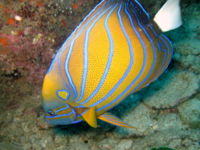Difference between revisions of "Pomacanthus annularis"
From The Aquarium Wiki
| Line 26: | Line 26: | ||
|min_sg=1.020 | |min_sg=1.020 | ||
|max_sg=1.025 | |max_sg=1.025 | ||
| − | |min_tank_size= | + | |min_tank_size=180 |
|min_tank_size_unit=Gallon | |min_tank_size_unit=Gallon | ||
|min_ph=8.1 | |min_ph=8.1 | ||
Latest revision as of 18:06, 15 June 2020
Bluering Angelfish
Pomacanthus annularis
681 Litres (180 US G.)
25.4-30.5cm (10-12 ")
8.1 - 8.4
22.2-25.6°C (72 -78 °F)
8-12 °d
1:1 M:F
5-8 years
Family
Pomacanthidae
This animal is available captive bred
| You can contribute to the Aquarium Wiki by expanding this article. Dont be shy!. |
Contents
Additional names
- Blue Ring Angelfish, Blue King Angelfish, Annularis Angelfish
Additional scientific names
- Chaetodon annularis, Pomacanthodes annularis
Origin[edit]
- East coast of Africa through Indonesia, and New Guinea to New Caledonia, and southern Japan
Sexing[edit]
- Requires close examination
Tank compatibility[edit]
- Should not be kept with most invertebrates, particularly soft corals and sponges, which comprise their diet.
Diet[edit]
- A good mix of prepared and fresh or frozen food, such as squid and sponge based flake food.
Feeding regime[edit]
- Daily
Environment specifics[edit]
- It is a very territorial fish, and should not be kept with other species of Angelfish in a small tank. However, they can be kept together in a tank large enough.
Behaviour[edit]
- Mixes with suitable tankmates.
Identification[edit]
- Juveniles have a black body with alternating white, and blue stripes, while adults have an orange or golden brown body with curved horizontal stripes radiating from the pectoral fin area to the posterior portion of the dorsal area.
Notes[edit]
Captive bred specimens are available. They are bred, and reared in land-based saltwater ponds in Bali, Indonesia.
Pictures[edit]
External links[edit]
- Fishbase (Mirrors:
 )
)

